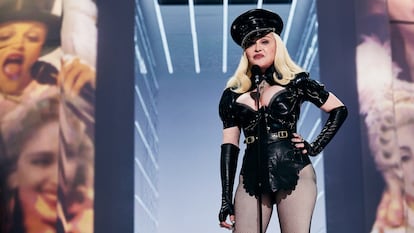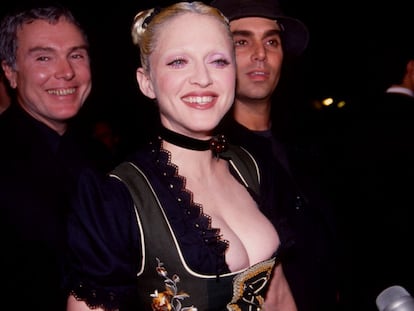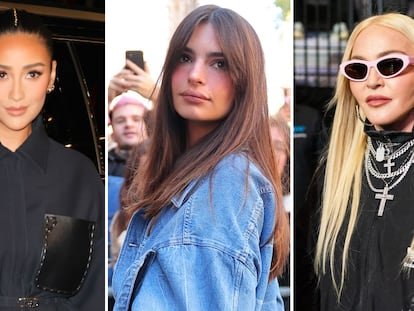Madonna and the taboo of female sexuality after middle age
The singer who shocked the world with her book ‘S.E.X’ has reinvented herself once again, this time as a sexy and sexual 63-year-old woman who refuses to be pigeon-holed
“Thirty years ago, I published a book called S.E.X. In addition to photos of me naked, there were photos of men kissing men, woman kissing woman [sic] and me kissing everyone. I also wrote about my sexual fantasies and shared my point of view about sexuality in an ironic way. I spent the next few years being interviewed by narrow minded people who tried to shame me for empowering myself as a Woman. I was called a whore, a witch, a heretic and the devil. Now Cardi B can sing about her WAP. Kim Kardashian can grace the cover of any magazine with her naked ass and Miley Cyrus can come in like a wrecking ball. You’re welcome bitches.” In 1992, when Madonna published S.E.X, an erotic book with explicit images shot by photographer Steven Meisel, the singer was 33 years old. When she posted the previous message on Instagram, commemorating the 30th anniversary of the book’s release, she was 63. What do 33-year-old Madonna and 63-year-old Madonna have in common? They have both been insulted, humiliated and criticized for openly expressing their sexuality. Before, it was because of her work. Now, it’s because of her social media.
The artist’s work is well-known: Madonna continues to wear the crown of queen of pop. The Guinness Book of Records considers her the most successful musical soloist in the world since the 20th century. She is also the best-selling female artist in history, surpassed only by The Beatles, Michael Jackson and Elvis Presley. Beyond that, she is an intergenerational icon, a star known in all corners of the planet. Throughout her career, she has been linked to two words: transgression and reinvention. Now, though, the public has access to parts of the artist’s life that previously remained hidden. Thanks to social networks, Madonna has reinvented herself once again, this time as a sexy and sexual 63-year-old woman in tight clothes, who shows off her intimate lingerie and her collection of vibrators with total naturalness and flirtatiousness. She takes selfies showing cleavage and smoking joints, and she joins TikTok trends. Her appearances on social networks have been widely commented on (and criticized). As she once stated: “People believed that one day they would wake up and it would no longer be there. But they were wrong: I will never leave.”
“Madonna’s sexuality has generated discomfort since the beginning of her career. To start, she chooses Madonna – virgin, in Italian – as her artistic name, with which she begins to flirt with the subject of religion from the beginning. On her second album, in 1984, he released the single Like A Virgin, where she dealt with the provocative issues of virginity and female sexual desire,” says Eduardo Viñuela, Doctor of Musicology from the University of Oviedo in Spain and editor of the book Bitch She’s Madonna. “From then on, she is combining two elements that will be fundamental in the provocation of Madonna: religion and sexuality.”
In the 1980s, MTV appeared. She took advantage of the moment: “The 1980s are MTV years, thanks in part to artists like Madonna,” explains the musicologist. The artist’s music videos were loaded with erotic signaling: “She plays at provocation through sexuality, but it is also an undefined sexuality, ambiguous, nor normative, nor hegemonic. She plays with androgyny, with homosexuality and lesbianism. Madonna is impossible to pigeonhole. And all these components do not fit well within a puritanical society like the United States and a patriarchal society in general.”
“Whether through the S.E.X book or the Erotica album, she has always shown herself as a woman who enjoys her sexuality openly, inviting others to live theirs freely and defending the right to experience sex and love however you want,” says Natalia Flores, co-author of the illustrated book Madonna. Una Biografía (Madonna. A Biography). “Madonna has brought to the mainstream ways of having relationships outside of heteronormative representations, and that has caused discomfort,” she adds.
Three decades have passed since the release of Madonna’s first album in 1983. And we continue to see a Madonna who enjoys the art of provocation through sex. Now, she is breaking yet another social taboo, as a woman over 60 who expresses her sexual desire. “If there is something controlled and restricted in our society, it is female sexuality. That works both ways, since women will always be criticized both for doing something and for not doing it; that is, criticism arises when they do not submit to what the male sex wants. In Madonna’s case, it is perfectly visible: the patriarchy wants to see women naked, but not when the woman undresses because she wants to, as she has done throughout her career, or when she wants, which is when she has grown older,” explains the writer Eulàlia Lledó Cunill.
“If we add that, in the eyes of society, a non-normative body is being shown, because it is an old body, the immediate response is: ‘What is she doing? What was she thinking?” continues the writer. “A woman over 60 should disappear, she should make herself invisible, she should wear clothes that cover her from the neck to her feet,” she adds. Lledó points out the double standard with which male and female sexual desire is judged: “In this society it is assumed that after a certain age women lose desire and lack sexual needs. In an older man, having desire is a merit and a source of pride (hence the little blue pills), but in a woman it is a transgression.”
“One of the fundamental issues is that we are facing something new, because there are no figures who have aged at the peak of the mainstream and within a musical genre that is designed for teenagers,” says Eduardo Viñas. Other musical genres such as jazz, soul, rock and classical music allow their artists to age, leading many pop artists to eventually embrace other genres that are considered more serious and mature. A figure like Madonna would typically be expected to execute a semi-retirement: she could focus on musical production, as a godmother of young artists, or she could have, like Cher, a show in Las Vegas, where she plays her greatest hits. But she is still active, and that too is an anomaly: “Madonna is breaking down cultural barriers that have long been thought of as biological, like the myth that menopause is the death of a woman’s sexuality because she no longer has the function to procreate. Here Madonna stands up and breaks the stereotype. She shows herself as a sexualized woman past 50, who continues to dance on stage, compose and create as if she were 30 years old. And for this, which is applauded for rockers like Mick Jagger, Iggy Pop or Keith Richards, Madonna is penalized.”
“One of her most significant speeches was the one she gave at the Billboard Awards in 2016, when she received Woman of the Year recognition,” says Natalia Flores. There, she spoke about the discrimination she suffered throughout her career. And she continues to experience it.
“What is happening with Madonna is a movement against her that has been in force throughout her entire career: trying to pigeonhole her, tame her, placate her, delegitimize her and discredit her,” says the musicologist. Nothing new under the sun, not even for her. As throughout her career, where she paved the way for other female artists and managed to change the course of the pop world through albums such as Music, Ray of Light and Confessions, she is also now exploring new territory: the of a female global pop superstar who is still active in her 60s and refuses to retire, go into hiding or disappear. Madonna took the world by storm with S.E.X and Erotica, and she continues to do so. And unsurprisingly, the patriarchy is not happy.
Tu suscripción se está usando en otro dispositivo
¿Quieres añadir otro usuario a tu suscripción?
Si continúas leyendo en este dispositivo, no se podrá leer en el otro.
FlechaTu suscripción se está usando en otro dispositivo y solo puedes acceder a EL PAÍS desde un dispositivo a la vez.
Si quieres compartir tu cuenta, cambia tu suscripción a la modalidad Premium, así podrás añadir otro usuario. Cada uno accederá con su propia cuenta de email, lo que os permitirá personalizar vuestra experiencia en EL PAÍS.
¿Tienes una suscripción de empresa? Accede aquí para contratar más cuentas.
En el caso de no saber quién está usando tu cuenta, te recomendamos cambiar tu contraseña aquí.
Si decides continuar compartiendo tu cuenta, este mensaje se mostrará en tu dispositivo y en el de la otra persona que está usando tu cuenta de forma indefinida, afectando a tu experiencia de lectura. Puedes consultar aquí los términos y condiciones de la suscripción digital.
More information
Archived In
Últimas noticias
Most viewed
- Sinaloa Cartel war is taking its toll on Los Chapitos
- Oona Chaplin: ‘I told James Cameron that I was living in a treehouse and starting a permaculture project with a friend’
- Reinhard Genzel, Nobel laureate in physics: ‘One-minute videos will never give you the truth’
- Why the price of coffee has skyrocketed: from Brazilian plantations to specialty coffee houses
- Silver prices are going crazy: This is what’s fueling the rally












































